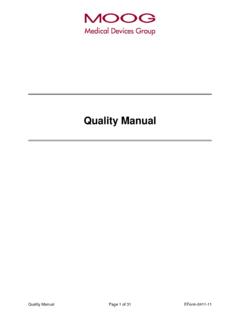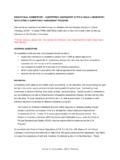Transcription of World Health Organization Manual for procurement
1 CONTACTD epartment of Essential Medicines and Health ProductsWorld Health Organization20 Avenue AppiaCH-1211 Geneva 27 SwitzerlandE-mail: and Laboratory Technology978 92 4 150029 6 Manual for procurement of diagnostics and related laboratory items and equipmentDiagnostics anD Laboratory technoLogy World Health Organization 2013 All rights reserved. Publications of the World Health Organization are available on the WHO web site ( ) or can be purchased from WHO Press, World Health Organization , 20 Avenue Appia, 1211 Geneva 27, Switzerland (tel.: +41 22 791 3264; fax: +41 22 791 4857; for permission to reproduce or translate WHO publications whether for sale or for noncommercial distribution should be addressed to WHO Press through the WHO web site ( copyright_form/ ). The designations employed and the presentation of the material in this publication do not imply the expression of any opinion whatsoever on the part of the World Health Organization concerning the legal status of any country, territory, city or area or of its authorities, or concerning the delimitation of its frontiers or boundaries.)
2 Dotted lines on maps represent approximate border lines for which there may not yet be full mention of specific companies or of certain manufacturers products does not imply that they are endorsed or recommended by the World Health Organization in preference to others of a similar nature that are not mentioned. Errors and omissions excepted, the names of proprietary products are distinguished by initial capital reasonable precautions have been taken by the World Health Organization to verify the information contained in this publication. However, the published material is being distributed without warranty of any kind, either expressed or implied. The responsibility for the interpretation and use of the material lies with the reader. In no event shall the World Health Organization be liable for damages arising from its publication contains the collective views of an international group of experts and does not necessarily represent the decision or the policies of the World Health Organization .
3 Layout by L IV Com S rl, Villars-sous-Yens, AND LABORATORY TECHNOLOGYC ontentsAbbreviations 2 Glossary 3 Scope and intended audience 41 Introduction Diagnostics-specific procurement challenges Process for procurement of diagnostics and related laboratory items/equipment 52 Planning phase needs Assessment Key stakeholders procurement planning Product selection using national guidance and policy standardization and harmonization testing strategies and nationally validated testing algorithms Regulatory approvals Performance and operational characteristics specific issues related to laboratory equipment Consumables and durables Infrastructure and utilities estimating requirements Quantification Forecasting 133 Implementation phase Product specifications procurement methods and solicitation documentation Vendor sourcing and pre-selection solicitation of bid Bid evaluation Bid response
4 Preliminary examination of bids evaluation of substantially responsive bids Contracting Contracting for equipment Requirements for installation training requirements Maintenance 214 Monitoring and evaluation phase Monitoring procurement practices evaluating supplier performance Post market surveillance for diagnostics Complaints monitoring Lot testing of consignments sampling of tests from field conditions 225 Donations 226 Bibliography 237 Annexes 24 Annex A. PsM Planning Phase Checklist 24 Annex B: Product selection Decision tree 25 Annex C: example technical specifications for diagnostics and generic laboratory products 262 Manual FOR procurement OF DIAGNOSTICS AND RELATED LABORATORY ITEMS AND EQUIPMENTDIAGNOSTICS AND LABORATORY TECHNOLOGYABBReVIAtIonsCD4CD4 T-lymphocyteCFRCost and FreightCIFCost Insurance and FreightEOIE xpression of InterestEQAexternal quality assessmentEQAS external quality assessment schemeG FAT MThe Global Fund to fight AIDS.
5 Tuberculosis and MalariaICBI nternational Competitive BiddingICCI nternational Chamber of CommerceINCOTERMI nternational Commercial TermsISOI nternational Standards OrganizationITBI nvitation to BidLTALong Term AgreementNRAN ational Regulatory AuthorityNRLN ational Reference LaboratoryPEPFARP resident's Emergency Plan for AIDS ReliefPOPurchase OrderPMI President's Malaria InitiativePSMP rocurement and Supply ManagementQAquality assuranceQCquality controlQMSquality management systemRFPR equest for ProposalRFQR equest for QuoteSOPS tandard Operating ProcedureSOWS cope of WorkTCOT otal Cost of OwnershipTORT erms of ReferenceUNUnited NationsUPSuninterrupted power supplyWHOW orld Health Organization3 DIAGNOSTICS AND LABORATORY TECHNOLOGYGLossARyAnalyteSubstances that are identified or measured by the test antibodies or antigenConsumablesItems that are used once during testing and are not reused gloves, pipette tips, this document refers to an in vitro diagnostic medical device such as rapid diagnostic test, enzyme immunoassays, and other that can be reused for multiple tests such as glassware, plastic ware, such as analyzers that may be used for a range of specific tests and general laboratory equipment such as centrifuges, pipettes and incubatorsExternal quality assessment A programme designed to assess laboratory performance, assessment of the quality of the entire testing process from collection of specimen, the testing procedure, to the reporting of testing results.
6 Usually composed of one or more of the following activities: site visits, participation in external quality assessment schemes/proficiency testing and inter-laboratory planProcurement and supply chain management plan Quality assurancePlanned and systematic activities to provide confidence that an Organization fulfills requirements for quality, to ensure the quality of the testing process including quality of diagnostics and controlA measure to control of the quality of the test itself. QC does not totally control for the provision of correct testing management systemA management system, comprising an organizational structure, procedures, processes and resources, to direct and control an Organization with regard to and biological components used in the testing processTest kitsIndividual platforms or devices that include reagents required to carry out a testWHO Prequalification of Diagnostics programme An assessment of the performance/operational characteristics and manufacturing quality of diagnostics, as performed by WHO4 Manual FOR procurement OF DIAGNOSTICS AND RELATED LABORATORY ITEMS AND EQUIPMENTDIAGNOSTICS AND LABORATORY TECHNOLOGYsCoPe AnD IntenDeD AuDIenCeThe purpose of the Manual for procurement of Diagnostics and Related Laboratory Items and Equipment is to provide information on procurement processes specific to HIV and related diagnostics, laboratory items and equipment.
7 This Manual is not intended to replace existing guidance on basic procurement processes but rather to enhance and extend current processes to include specific issues related to diagnostics and related items/equipment that are considered essential to ensure high quality testing intended audience includes procurement officers, HIV programme managers and end-users of diagnostics, staff in United Nations (UN) agencies and non-governmental organizations (NGOs) who are responsible for the selection, use and procurement of diagnostics and related laboratory items and equipment. Users of this Manual who procure with financial resources from multilateral or bilateral agencies or sources other than national funds will be obliged to also follow the rules, regulations and policies of the funding/procuring Organization . The following documents are used more generally to guide UN procurement and may provide the basis for other procuring organizations to organize their procurement processes:1.
8 UN procurement Practitioner s Handbook, Revision (September 2012) Web address UN procurement Manual , Revision 06, (March 2012) Web address section 6 (bibliography) for further useful IntRoDuCtIonAccess to accurate, safe and appropriate diagnostics and reliable laboratory services is paramount for diagnosis and disease management, surveillance and securing a safe blood supply. However, testing results are only of value to those making clinical decisions if the test results reported are timely and correct. Selection and procurement of diagnostics and laboratory technologies is often challenging given the wide choice of products and suppliers in the global market. Understanding of the needs at each level of the Health system is critical and should be the first step. Clear technical specifications and good procurement practices are necessary to guide sound procurement decisions. This is especially important to ensure that appropriate and safe diagnostics of good quality are placed in Health facilities according to the needs.
9 Service delivery systems may need to be adapted to ensure that access to diagnostics is equitable; meaning access to testing services can reach all of those in need. Technical experts with specific knowledge in the selection and use of diagnostics, including end-users, should be involved in procurement processes for diagnostics and laboratory Diagnostics-specific procurement challenges Unlike pharmaceutical products, methods for selection and procurement of diagnostics have to be tailored to the end user, hence, procedures may differ between the types of diagnostics. In particular, the desired testing throughput, staff competencies and training requirements, and site infrastructure will greatly impact the choice of diagnostic in a particular Health facility. A combination of factors, at the facility level and at the national level need to be considered when selecting diagnostics.
10 In addition to national policies and guidelines, financial and regulatory factors may impact national capacity to select and manage particular types of diagnostics. Disease patterns that are national, regional and seasonal may dictate the required scope of services and throughput in specific locales. At facility level, facility infrastructure including stability of utilities, cold chain and/or appropriate storage, human resources capacity, staff competencies, training, local service and technical support, test through-put, and quality assurance measures will all contribute to product selection and therefore procurement of testing site should be operated within a quality management system (see figure 1). A quality management system defines a systematic approach to ensuring quality testing through use of standard operating procedures, management of documents and records, implementation of quality control, and participation in external quality assessment.














